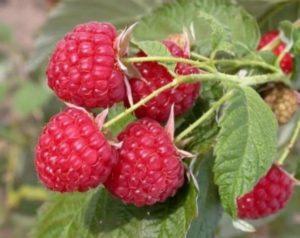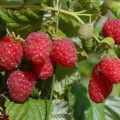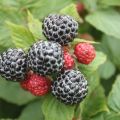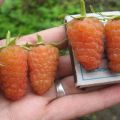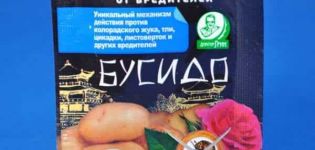Why raspberries can dry with berries and what to do, how to fight and how to process
All their free time summer residents feed, weed, water the plants, loosen the ground and look forward to the harvest of fruits and vegetables. Gardeners rejoice at the appearance of an ovary on shrubs, the formation of fruits, but after a while they notice that raspberries are drying out along with the berries, why this happens is immediately difficult to understand. By drying out the foliage and fruits, the plant reacts to a lack of light or moisture, but if this is not the problem, the cause of the phenomenon is even more difficult to determine.
In what season are raspberry bushes most prone to wilting and drying
Stalk death syndrome is more common in the height of summer. Shoots and leaves begin to dry when berries have already set on the branches. Raspberries love the sun, but they grow quickly, plantings thicken, it becomes more difficult for bushes to get nutrients, and some of them dry out, while others continue to develop.
The culture is demanding on nitrogen. If mineral fertilizers have not been applied to the ground since spring, by the summer the reserves of the substance decrease, the raspberry stops growing, begins to wither, the ovary crumbles. On sandy soil, nutrient salts do not linger for a long time and are washed out with water.
Common Causes and Symptoms of Drying Raspberry Bushes
Various natural factors contribute to the death of stems. The young shoot cracks when pest larvae penetrate inside. Berries can dry out if the plant is infected with a viral infection.
Bad weather
Raspberry leaves turn yellow in extreme heat, when it lacks moisture. If the shrub is planted in a lowland, after prolonged rains and heavy showers, groundwater rises to the surface, which is fraught with rotting roots, wilting shoots. Damp weather promotes the activation of fungi that cause various diseases.
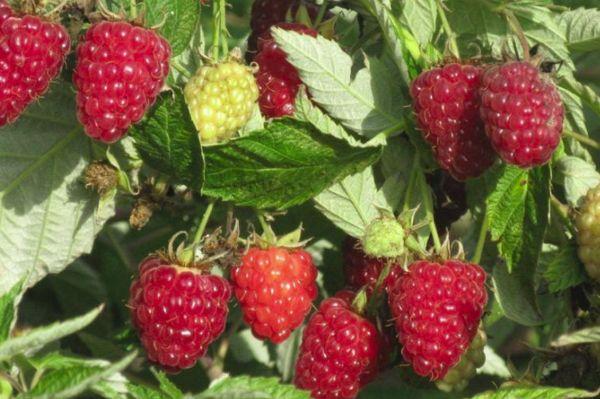
Improper care
The shrub grows rapidly, takes root, on which offspring and new shoots are formed. If you do not remove excess growth, do not thin out the plantings, raspberries turn yellow and dry out, because they lack neither the sun nor nutrients.
The bushes must be properly watered, the soil must be moist, but the culture does not tolerate stagnant water. The branches dry up, the berries crumble due to a lack of nutrients, if the plant is planted in depleted soil, and fertilizers are not applied.
Diseases
With inadequate care, combined with adverse weather conditions, raspberries become vulnerable to viral infection and are affected by curl and mosaic.

With excessive moisture and thickening of the plantings, fungi multiply, which causes the occurrence of:
- anthracnose;
- gray rot;
- powdery mildew;
- ulcerative spot.
During the ripening period of the berries, raspberries dry out with verticillosis. Although the disease occurs after a cool spring, the first signs are associated with the onset of heat. The lower leaves of black-fruited varieties fade in June, then turn yellow throughout the bush and wither, purple stripes appear on the shoots.
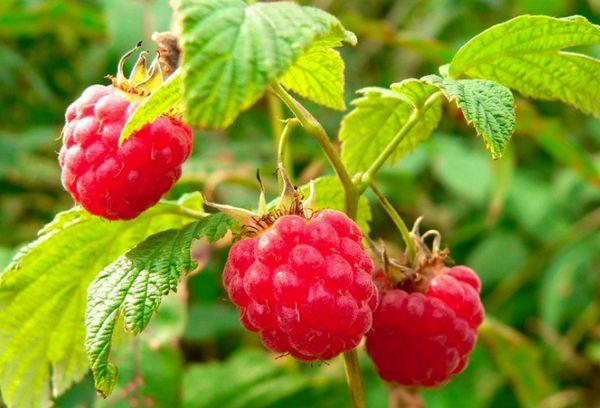
Red raspberries are attacked by a fungus that causes verticillosis, a month later - in July. The symptoms of the disease are less pronounced than in black-fruited varieties, but the berries on the bushes ripen unevenly, become tasteless and often dry out.
In wet weather and high humidity, rust appears. The leaves and stems of the bush become covered with ulcers, turn yellow and dry. Productivity with this disease drops by 30%. The mycelium of the fungus is directed to the tissue. Young animals especially suffer from it. The shoots seem to begin to rust, break and dry out. Raspberry dries and dies from stem and bacterial cancer.
The edges of the leaves curl, the ends dry out during fruiting when infected with yellow mosaic. The disease makes itself felt in May and early August.
Chlorosis
The virus that multiplies in plant cells is carried by aphids and ticks and causes a disease that is almost impossible to cure. In infected bushes, in May, the leaves along the veins change color, then spots appear. The shoots of infected raspberries become thin, begin to dry out before they mature. Physiological chlorosis occurs in damp and cold weather, with a deficiency of trace elements in the form of:
- gland;
- boron;
- nitrogen;
- manganese.
Not all summer residents know what to do with dying bushes. Plants need to be dug up and burned. Spring treatment of raspberries with the drug "Nitrafen" helps to prevent the spread of infection, which kills the insects that carry it. It is necessary to fight aphids without waiting for flowering, the shrub is sprayed with a solution of methylmercaptophos.

Anthracnose
If the air humidity reaches 90%, the temperature exceeds 22 ° C, the Colletotrichum orbiculare fungus is activated, which causes anthracnose. The pathogen is transmitted by insects, transferred with an infected tool, seeds:
- First, a brown spot appears on the leaf, it increases in size and spreads.
- Stripes appear on young stems, in their place are rings of a dark purple color.
- Shoots crack in drought, rot in rain and wet weather.
If anthracnose develops during fruiting, the berries dry out. You need to fight the infection in a comprehensive manner. It is necessary to cut and burn infected shoots, dig up the ground under the bushes, and thin out the plantings. Not all summer residents know how to process raspberries to prevent anthracnose.
To prevent the activation of fungi, the shrubs are sprayed with solutions of copper oxychloride or "Kuprozan" during the growth of shoots, in May and when flowering begins. It is impossible to cure the plant with folk remedies. The remontant raspberry is resistant to diseases.

Pests
Fruit shrubs often attract parasites. Many of them suck the juice from the leaves, which in the absence of urgent measures ends not only with the yellowing of the plant, but also with its death. Huge harm to raspberries is brought by:
- nematodes;
- stem flies;
- spider mite;
- glass case.
Microscopic aphids lay eggs, from which more than one colony of insects is formed, that after drinking the juice, they begin to feed on the stems of the plant.
Raspberry weevil devours green leaves, eats buds and flowers.Gall midge grows and multiplies in the cracks of young shoots. Orange insect larvae crawl into the ground for the winter, wake up in May and eat tender shoots.

The glass-maker loves damp weather and lays eggs in rainy summers. The offspring are not averse to feasting on green foliage.
Nematodes settle inside raspberries, multiplying, damage the bush, the fruits are deformed and dry out.
The stem fly larvae will climb inside the shoots and make moves in a spiral from top to bottom. The bush wilts and bends towards the ground.
In heat and drought, ticks attack raspberries. They envelop it in cobwebs, pierce the leaves with their proboscis to drink the juice.
Physical damage to the roots
Aboveground shoots from a shrub live only a year or 2, and then die off. Young shoots begin to dry not only from diseases, but also when the roots are damaged by the larvae of the May beetle, with inaccurate loosening of the earth.
What to do: rescue scheme
It happens that the berries are already beginning to turn red, and the leaves curl and dry out, so as not to lose the harvest, you need to find out the problem, and, without delay, start to eliminate it.
If the leaves turn yellow
Raspberry reacts negatively to micronutrient deficiencies, excess and lack of moisture. With the development of physiological chlorosis, the bushes are fed with fertilizers containing nitrogen, watered with diluted poultry droppings, but potassium salt, manure and superphosphate are not added. Raspberries turn yellow and dry out from the heat; in dry and sultry weather, you just need to water the plants more often with warm water. When it rains frequently, irrigation must be abandoned.
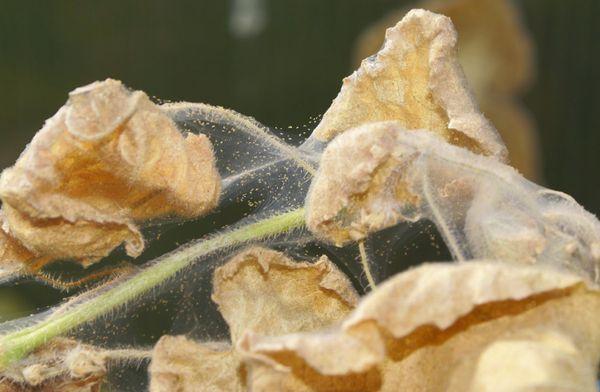
If the leaves dry and curl during fruiting
Aphids carry viruses that cause yellow mosaics. The disease may not appear for a long time, but during the ripening of the berries, light spots appear, the tops of the leaves are twisted and deformed. To prevent the development of the disease, the bushes are treated with fungicides. The preparations "Inta-Vir", "Iskra" are used to cope with insects carried by pathogenic microorganisms. The diseased leaves are cut off and burned.
If the stems dry
At high temperatures, excess moisture and thickening of the plantings, anthracnose pathogens are activated. Raspberry shoots become stained, stems dry out. To prevent the onset of the disease:
- Weeds are removed regularly.
- Weed landings.
- In the spring, the raspberries are sprayed with Bordeaux liquid.
- A solution is prepared from "Alirin B", the plants are treated in summer every decade.
It is useless to treat infected bushes, they need to be removed and burned, and the ground should be treated with copper oxychloride and the Oxyhom fungicide.
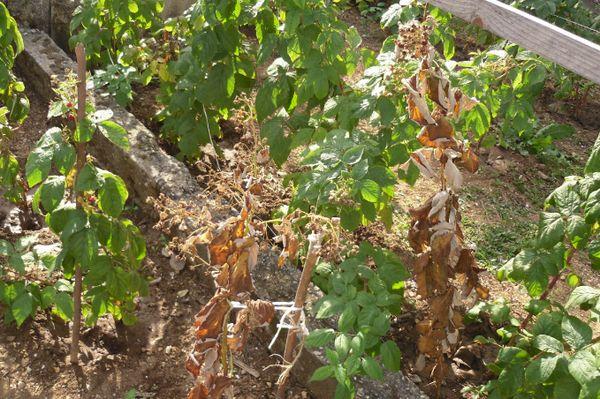
If raspberries dry up on the site along with berries
To prevent the plant from drying out during the fruiting period, it is necessary to follow agricultural techniques when planting, regularly feed and water the bushes, remove old shoots, thin out young shoots. Such methods help to strengthen the immune system. To protect against fungi and viral infection, raspberries are treated with Bordeaux liquid, "Oxyhom" or urea. If the plant dries up from the invasion of pests, use insecticides "Actellik", "Intavir". It is better to dig up the affected bushes and burn them.
If the branches dry
Berries on raspberries are formed only on annual shoots, old ones begin to dry out and die off. Regular pruning can help rejuvenate the shrub. Branches dry with a lack of moisture. In this case, the raspberries are watered abundantly. If the plant is damaged by insects, start treatment with insecticides.

How to protect and cure raspberries from diseases and pests
For the prevention of wilting of fruit shrubs during the period of fruit ripening, you need to acquire strong, healthy planting material. Drying or waterlogging of the earth, thickening of the site should not be allowed. It is necessary in a timely manner:
- cut out infected and old shoots;
- dig up and burn bushes that are not amenable to treatment;
- to feed the plants with organic matter and mineral components.
For the winter, the raspberry trunk circle is covered with needles or sawdust. To protect plants from spider mites, the bushes are sprayed with urea in the spring. Leaves may turn yellow if the shoots are infected with gall midge. They get rid of the pest by digging up the soil in spring and autumn, treating the area with bleach.
